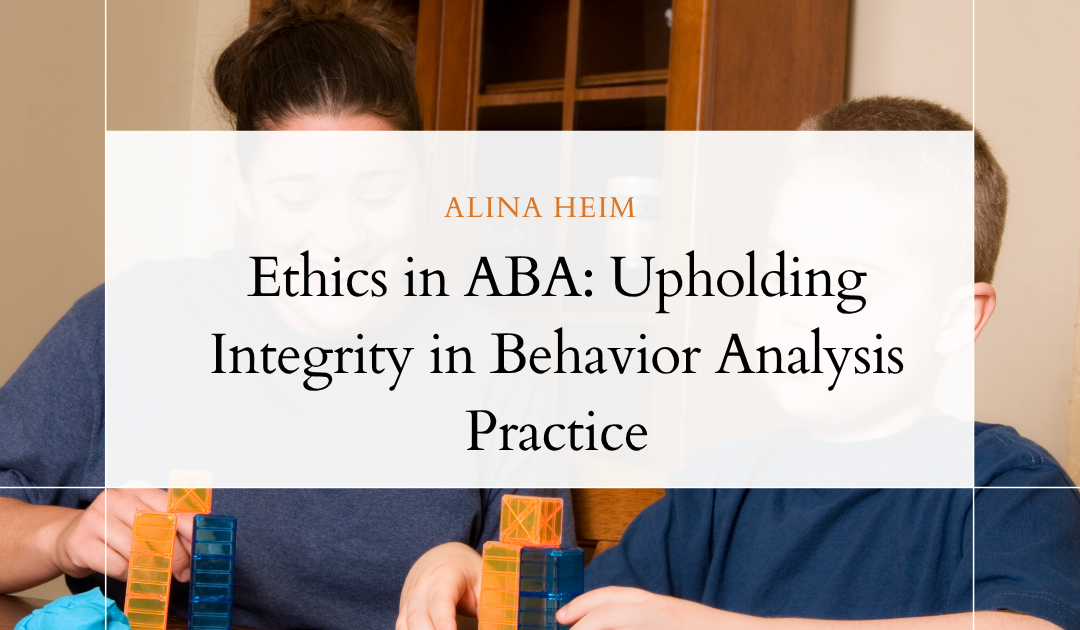Ethical behavior is the backbone of effective and respectful Applied Behavior Analysis (ABA) services. Board Certified Behavior Analysts (BCBAs), Registered Behavior Technicians (RBTs), and all ABA professionals are guided by a stringent set of ethical standards set forth by the Behavior Analyst Certification Board (BACB). This blog explores the importance of ethics in ABA, key principles of the BACB Ethics Code, and common dilemmas faced in practice.
Why Ethics Matter in ABA
- Protects Client Rights: Ensures services are delivered with dignity, safety, and respect.
- Promotes Trust: Builds strong relationships between professionals, families, and clients.
- Maintains Professional Integrity: Helps avoid conflicts of interest and maintains the field’s credibility.
- Supports Effective Practice: Encourages evidence-based, non-harmful, and socially significant interventions.
Overview of the BACB Ethics Code (2022)
The BACB’s Ethics Code for Behavior Analysts includes four key sections:
- Responsibility to Clients
- Prioritize client welfare and autonomy.
- Obtain informed consent and ensure confidentiality.
- Responsibility to the Profession
- Maintain competence and integrity.
- Refrain from using the profession for personal gain or making false claims.
- Responsibility to Colleagues and Organizations
- Collaborate professionally.
- Address unethical conduct by others.
- Responsibility in Public Statements and Research
- Communicate truthfully in advertising and publications.
- Ensure accurate representation of services and outcomes.
Common Ethical Dilemmas in ABA
- Dual Relationships
- Example: Providing services to a family friend.
- Resolution: Avoid whenever possible; consult with supervisors when in doubt.
- Confidentiality Breaches
- Example: Discussing client cases in public or unsecured settings.
- Resolution: Always use de-identified information and secure communication methods.
- Scope of Competence
- Example: Accepting a case involving a diagnosis outside one’s training.
- Resolution: Seek additional training or refer to a more qualified provider.
- Consent and Assent
- Example: Implementing behavior plans without caregiver understanding.
- Resolution: Ensure informed consent and revisit it as needed.
- Use of Aversive Procedures
- Example: Using punishment-based strategies without exhausting positive interventions.
- Resolution: Prioritize reinforcement-based strategies and follow strict protocols if aversives are considered.
Promoting Ethical Practice
- Ongoing Training: Attend workshops and courses on ethics.
- Supervision and Mentorship: Discuss ethical issues with experienced professionals.
- Ethics Checklists: Use tools to evaluate decisions before implementing them.
- Client-Centered Thinking: Always consider what is best for the client, even when it’s inconvenient.
Creating an Ethical Workplace Culture
- Foster open communication about ethical concerns.
- Encourage reporting of unethical behavior without retaliation.
- Establish clear procedures for ethical decision-making.
Reporting Ethical Violations
- First address concerns internally (e.g., via a supervisor or ethics committee).
- If unresolved or severe, file a report with the BACB.
- Maintain documentation of concerns and actions taken.
Conclusion
Ethics in ABA are more than rules—they are the compass that guides compassionate, respectful, and effective services. As the field continues to grow, maintaining high ethical standards ensures that clients benefit from safe, individualized, and evidence-based care. For every ABA professional, ethical behavior is not optional—it’s a responsibility and a privilege.

